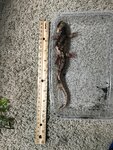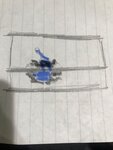JaceW/Lifer-Log
Active member
- Joined
- Aug 10, 2020
- Messages
- 188
- Reaction score
- 74
- Points
- 28
- Location
- United States
- Country
- United States
Hello Caudata.org,
My Eastern Tiger Salamander turned three this year and has barely just made it past 10 inches! Clearly an adult.
I haven't had to brumate him since he had still been a juvenile, always active and never really resting. He has calmed down a little, still exploring his enclosure just later at night. I have observed a loss in appetite and lack of movement from him, I relate this to the 65-70 degrees (Fahrenheit) in my household. I drew this conclusion first from his feeding behavior, he used to gulp up a nightcrawler extremely fast, but in the past month and a half, he has started losing interest in tong fed food and preferred to hunt on his own. (I did this by holding the worm in the forceps and then letting it sit checking every five minutes to release the worm for him to finish it.) I needed to do this twice than he didn't take the worms, even after a hunt. I got a pair of waxworms for his birthday and some superworms to try and get him to eat. He took one waxworm instantly, and a superworm follow up after refusing the second waxworm. After that, he refused all the rest of the food. I tried a few of my isopods even though the culture was just starting, he took the two I offered in an instant. this all happened in mid to late-August, where my house started to cool down, now in September it has been routinely under 70 degrees. (Fahrenheit, again.) The most recent feeding he didn't take the worm but put up quite a hunt and snapped at it a few times. I gave him two superworms, he ate both.
So, I assume this is all signs of brumation, how do I go about helping him proceed in this process and care for him during brumation? Do you feel concerns about an issue or problem not related to brumation when reading, what is It, and what actions could I possibly take?
Thank you, JaceW/
My Eastern Tiger Salamander turned three this year and has barely just made it past 10 inches! Clearly an adult.
I haven't had to brumate him since he had still been a juvenile, always active and never really resting. He has calmed down a little, still exploring his enclosure just later at night. I have observed a loss in appetite and lack of movement from him, I relate this to the 65-70 degrees (Fahrenheit) in my household. I drew this conclusion first from his feeding behavior, he used to gulp up a nightcrawler extremely fast, but in the past month and a half, he has started losing interest in tong fed food and preferred to hunt on his own. (I did this by holding the worm in the forceps and then letting it sit checking every five minutes to release the worm for him to finish it.) I needed to do this twice than he didn't take the worms, even after a hunt. I got a pair of waxworms for his birthday and some superworms to try and get him to eat. He took one waxworm instantly, and a superworm follow up after refusing the second waxworm. After that, he refused all the rest of the food. I tried a few of my isopods even though the culture was just starting, he took the two I offered in an instant. this all happened in mid to late-August, where my house started to cool down, now in September it has been routinely under 70 degrees. (Fahrenheit, again.) The most recent feeding he didn't take the worm but put up quite a hunt and snapped at it a few times. I gave him two superworms, he ate both.
So, I assume this is all signs of brumation, how do I go about helping him proceed in this process and care for him during brumation? Do you feel concerns about an issue or problem not related to brumation when reading, what is It, and what actions could I possibly take?
Thank you, JaceW/



